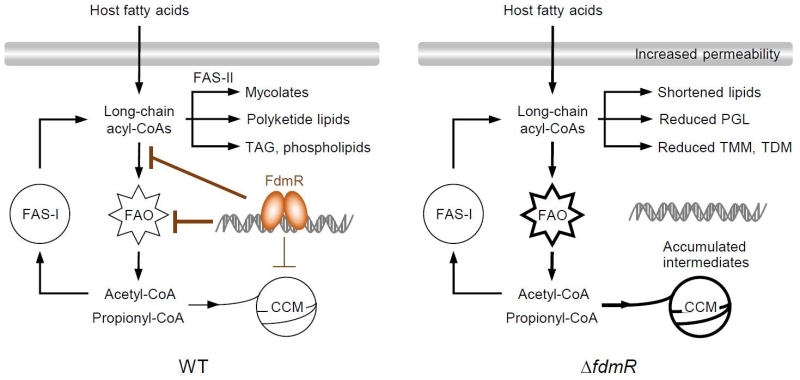Scientists Discovered a Key Regulator of Mycobacterial Fatty Acid Metabolism
Pathogenic mycobacteria remain a serious threat to public health throughout the world. For example, Mycobacterium tuberculosis, the causative agent of human tuberculosis (TB), is responsible for more than 1 million deaths each year. In the 1950s, it was determined that M. tuberculosis, the causative agent of human tuberculosis, preferentially metabolizes fatty acids when recovered from the lungs of infected animals. Since then, numerous studies have demonstrated that host-derived fatty acids are an important carbon source for pathogenic mycobacteria during infection. How mycobacterial cells regulate the catabolism of fatty acids to serve the pathogenicity, however, remains unknown.
Recently, Dong et al. from the Center for Excellence in Molecular Plant Sciences of the Chinese Academy of Sciences and Fudan University identified a TetR-family transcriptional factor, FdmR, as the key regulator of fatty acid catabolism in the pathogen Mycobacterium marinum by combining use of dynamic 13C-based flux analysis, metabolomics, lipidomics, and other omics techniques. A mutant deficient in FdmR was severely attenuated in zebrafish, which indicates that FdmR is crucial for mycobacterial virulence. Interestingly, the mutant showed defective growth but high substrate consumption on fatty acids. FdmR was identified as a long-chain acyl-coenzyme A (acyl-CoA)-responsive repressor of genes involved in fatty acid degradation and modification. FdmR was demonstrated to function as a valve to direct the flux of exogenously derived fatty acids away from β-oxidation towards lipid biosynthesis, thereby avoiding the overactive catabolism and accumulation of biologically toxic intermediates. Moreover, it was found that FdmR suppresses degradation of long-chain acyl-CoAs endogenously synthesized through the type I fatty acid synthase. By modulating the supply of long-chain acyl-CoAs for lipogenesis, FdmR controls the abundance and chain length of virulence-associated lipids and mycolates and thus plays an important role in the impermeability of the cell envelop and the intrinsic drug resistance.
These results reveal that despite the fact that host-derived fatty acids are used as an important carbon source, overactive catabolism of fatty acids is detrimental to mycobacterial cell growth and pathogenicity. FdmR is highly conserved among pathogenic mycobacteria. Little sequence variation was observed for FdmR in clinical M. tuberculosis strains. Thus, this study presents FdmR as a potentially attractive target for novel therapeutic intervention.
The research article “Mycobacterial fatty acid catabolism is repressed by FdmR to sustain lipogenesis and virulence” has been published in PNAS. This work was supported by the National Natural Science Foundation of China, the Chinese Academy of Sciences, and the Ministry of Science and Technology of China.

Article link: https://doi.org/10.1073/pnas.2019305118
Contact: Prof. Chen Yang
Key Laboratory of Synthetic Biology, CAS Center for Excellence in Molecular Plant Sciences (CEMPS), Chinese Academic of Sciences
Email: cyang@cemps.ac.cn